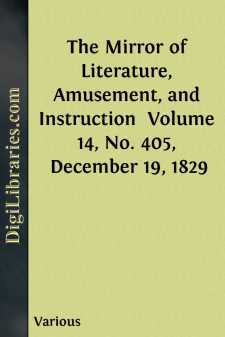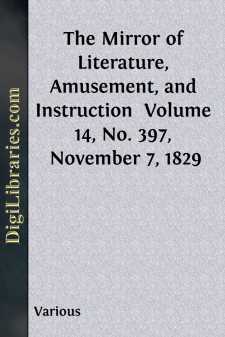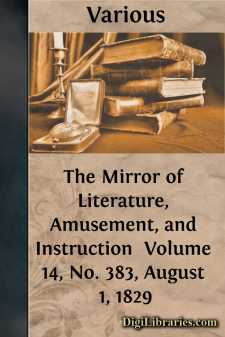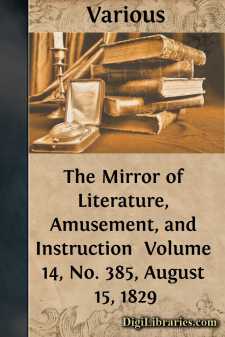Periodicals
- Art 27
- Children's periodicals 59
- Entertainment 5
- Food/Wine 2
- Games/Humor 455
- General
- Health 1
- History 53
- House/Home 1
- Regional 62
- Science/Nature 118
- Transportation 10
General Books
Sort by:
by:
Various
CASTLE OF VINCENNES. Every reader at all conversant with the history of the present century, or the past year, will appreciate our choice of the above Engraving. Its pictorial and historical interest will not bear comparison; unless it be in the strong contrast which the gloomy, wretched-looking building affords with the beautiful paysage of the scene. The spectator may perhaps reflect on the damning...
more...
by:
Various
The Leaning Towers of Bologna. The Landscape Annual.LONDON AND PARIS, 1830.MAGNIFIQUE! SUPERBE! will be the exclamation of the Parisians on beholding the Plates of this Work, at the Publishers, in the Gallerie Vivienne, and equally enthusiastic will be the admiration of all Londoners whilst inspecting them in Cheapside. The second title, "The Tourist in Italy and Switzerland," implies the...
more...
by:
Various
Petrarch and Arquà; Ariosto, Tasso, and Ferrara;—how delightfully are these names and sites linked in the fervour of Italian poetry. Lord Byron halted at these consecrated spots, in his "Pilgrimage" through the land of song:— There is a tomb in Arquà;—rear'd in air, Pillar'd in their sarcophagus, repose The bones of Laura's lover: here repair Many familiar with his...
more...
by:
Various
NEW BUILDINGS, INNER TEMPLE. "The Temple," as our readers may be aware, is an immense range of buildings, stretching from Fleet-street to the River Thames, north and south; and from Lombard-street, Whitefriars, to Essex-street, in the Strand, east and west. It takes its name from having been the principal establishment, in England, of the Knights Templars; and here, in the thirteenth century...
more...
by:
Various
VIRGIL'S TOMB. This consecrated relic of genius stands on the hill of Posilipo, in the environs of Naples. Its recent state is so beautifully described by Eustace, that we shall not, like gipsys do stolen children, disfigure it to prevent recognition. Proceeding westward along the Chiaia and keeping towards the beach, says Eustace, we came to the quarter called Mergyllina. To ascend the hill of...
more...
by:
Various
ST. DUNSTAN'S, FLEET STREET. No church in London is perhaps better known than the above, which is distinctively called Saint Dunstan's in the West. External elegance has little to do with this celebrity, which has been acquired by the two wooden figures placed on a pediment in front, representing savages, who indicate the hours and quarters by striking a bell with their clubs: this has caused...
more...
by:
Various
Burleigh, Northamptonshire. The above is a view of the grand screen and entrance lodges to Burleigh, or Burghley, the seat of the Cecil family, and now the property of the Marquess of Exeter. The house and principal part of the demesne, are within the parish of Stamford St. Martin, in the church of which are some costly monuments to several eminent persons of the Cecil family; and this estate gave...
more...
by:
Various
TUNBRIDGE WELLS. With sketches of Dr. Johnson, Cibber, Garrick, Lyttleton, Richardson, &c. &c. For Explanation, see the annexed page. References to the Characters in the Engraving. 1. Dr. Johnson.—2. Bishop of Salisbury (Dr. Gilbert.)—3. Lord Harcourt.—4. Cotley Cibber.—5. Mr. Garrick.—6. Mrs. Frasi, the singer.—7. Mr. Nash.—8. Miss Chudleigh (Duchess of Kingston.)—9. Mr. Pitt...
more...
by:
Various
HAMPTON COURT. Here is a bird's-eye view of a royal palace and domain "cut out in little stars." It is copied from one of Kipp's Views in Great Britain in the time of Queen Anne, and affords a correct idea of Hampton Court in all its olden splendour. The palace is situated on the north bank of the Thames, two miles west from Kingston. It was magnificently built by Cardinal Wolsey....
more...
by:
Various
MR. GURNEY'S IMPROVED STEAM CARRIAGE. Mr. Gurney, in perfecting this invention, has followed Dr. Franklin's advice—to tire and begin again. It is now four years since he first commenced his ingenious enterprise; and nearly two years since we reported and illustrated the progress he had made. (See MIRROR, vol. x. page 393, or No. 287.) He began with a large boiler, but public prejudice was...
more...











